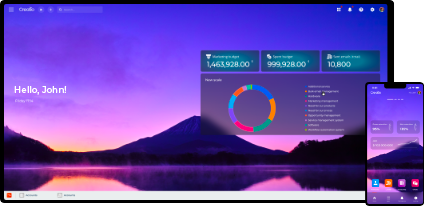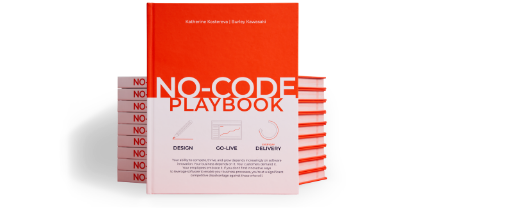Revenue Forecasting Guide

Revenue forecasting empowers organizations to plan their growth, mitigate risks, and manage finances efficiently. Accurate revenue forecasts play a key role in revenue growth and business strategy. And yet, according to the 2024 survey by Xactly, 98% of finance and Revenue Operations teams struggle to generate accurate revenue forecasts.
Indeed, revenue forecasting is a challenging process that requires robust data management, reliable software, and a good understanding of the revenue forecasting process to ensure accurate and actionable forecasts in the ever-changing business market.
In this article, we explain why businesses use revenue forecasting, go through the most common revenue forecasting models, and give instructions on how to build a robust revenue forecasting process powered by AI-native CRM software.
What is Revenue Forecasting?
Revenue forecasting is the process of estimating a company’s future revenue growth or decrease over a specific period to support businesses’ financial planning, resource allocation, and sustainable business growth.
These revenue projections are based on the analysis of historical data, business strategy, market trends, and external factors.
Unlike sales forecasts, revenue forecasting takes a more holistic approach, focusing on all revenue-generating activities as well as market dynamics. In addition to expected sales results, revenue forecasting considers product, sales, and marketing strategies, upcoming marketing campaigns, competitive conditions, economic trends, and other external and internal factors that may affect your future revenue.
Why Companies Need Revenue Forecasting
Revenue forecasting provides valuable insights for businesses of all sizes, from startups to large enterprises.
Accurate revenue forecasts help growing companies allocate resources efficiently to maximize return on investment. This advantage is especially important for startups and small businesses with limited cash flow. Revenue forecasting enables them to understand how current business decisions affect future revenue growth and what marketing and sales strategies are yielding the best results.
For example, if a SaaS startup forecasts a 10% increase in future revenue for the quarter based on historical data, it may plan to hire more customer service representatives to support new users.
For larger enterprises, revenue forecasting plays a key role in managing growth and financial strategy. It enables business leaders to make informed decisions about product development, market expansion, and capital investments.
Publicly traded companies often share revenue forecasts with financial markets, where analysts closely monitor growth rates to guide investment decisions. These forecasts play a key role in analysts' financial models, and missing revenue projections can lead to stock downgrades and sell recommendations.
Similarly, private companies seeking loans, venture capital, a private equity investment, or preparing for a sale, also provide revenue forecasts to demonstrate healthy cash flow and business growth potential.
Publicly traded companies often share revenue forecasts with Wall Street, where analysts closely monitor growth rates to guide investment decisions. These forecasts play a key role in analysts' financial models, and missing projections—especially repeatedly—can lead to stock downgrades and sell recommendations. Similarly, private companies seeking loans, venture capital, or private equity investment, or preparing for a sale, also provide revenue forecasts to demonstrate financial health and growth potential.
All in all, revenue forecasting enables businesses to identify growth opportunities and mitigate potential risks, ensuring long-term success.
Top Revenue Forecasting Benefits
Smart resource allocation
Revenue forecasting helps businesses determine how to allocate resources effectively for maximum ROI. If a forecast predicts slower cash flow in the coming quarter, a company may delay hiring or reduce marketing spending to maintain profitability.
Conversely, if higher future revenue is expected, the business can confidently invest in growth initiatives and marketing efforts, knowing they have the financial stability to support expansion.
Improved productivity of revenue-generating teams
Revenue forecasting allows companies to set achievable goals for their marketing and sales teams and track their progress. Accurate revenue forecasts based on historical data help both supervisors and team members understand the reasoning behind their targets and notice underperformance.
Effective revenue forecasting can help teams analyze weak strategies and identify areas of opportunity that impact revenue.
For instance, if sales teams fall short of quarterly projections, leadership can identify whether the issue lies in pricing, marketing efforts, product changes, or external market conditions and take corrective action.
Risk mitigation
Economic downturns, changes in consumer demand, or supply chain disruptions can impact revenue, but companies with accurate forecasts can develop contingency plans to minimize risk.
For example, if an organization's revenue forecasting model predicts a slowdown in sales, it may diversify its product offerings or explore new markets to maintain cash flow.
How to Forecast Revenue in 7 Steps
For organizations new to revenue forecasting, it can be a challenge to start. Do you purchase forecasting software, gather historical data, or run a market analysis?
This section outlines key steps and important considerations for predicting future revenue.

Step 1. Choose a forecasting tool
Start by determining what software you are going to use for revenue forecasting.
You can choose a CRM with built-in forecasting functionality, such as Creatio, that leverages real-time CRM data for more accurate predictions. A centralized CRM system makes revenue forecasting highly optimized, as it already has access to customer data, sales trends, and deal pipelines, allowing for more dynamic and precise forecasts. If you decide to go with this option, make sure your CRM supports various forecasting models, utilizes AI, and offers custom reports.
There are also standalone forecasting tools that are often tailored to specific industries and business models. When choosing a specialized forecasting solution, make sure it integrates with other systems in your tech stack that store relevant data, such as CRM, ERP, or financial software.
You can also use spreadsheets for manual revenue forecasting at a smaller scale.
No matter what revenue forecasting tool you choose, it should align with your business and integrate seamlessly with existing systems.
Smaller organizations with straightforward models, like subscription-based services, may benefit from simpler solutions, while enterprise-level companies with multiple revenue streams require more advanced and customizable revenue forecasting software.
Step 2. Define the forecasting period
Decide whether you are forecasting revenue monthly, quarterly, or annually. Short-term forecasts (e.g., monthly) provide immediate insights to determine targets and track your performance, while long-term forecasts (e.g., annual) help with strategic planning.
If you're using software, it will enable you to generate multiple short-term and long-term forecasts based on real-time data points.
Step 3. Gather relevant data
Collect data that can be used for revenue projections, including:
- Historical data from sales and lead generation channels.
- Market and economic conditions to understand external influences.
- Customer behavior and demand trends based on past performance.
- Competitor research focused on product strategy and marketing efforts.
- Internal business plans like pricing changes, product launches, or marketing campaigns.
The more data you provide, the more accurate revenue forecasts will be.
Step 4. Choose a revenue forecasting method
Choosing the right model depends on the available data, your business model, and your forecast goals. Most revenue forecasting models rely on extensive historical data, including past revenue, closed sales, lead volume, and pipeline trends. Some also require more insights into product strategy and external conditions.
For short-term forecasts, simpler models like moving averages can be effective, while long-term strategic predictions benefit from more comprehensive approaches, such as regression analysis, which accounts for both internal and external influences. It may take several revenue forecasting attempts before you find the best forecasting method for your organization.
In the next section, we explore the most common revenue forecasting models and their ideal use cases.
Step 5. Adjust for risks and external factors
Account for uncertainties by incorporating risk factors that may affect revenue growth into your forecast. These include:
- Market downturns or economic recessions.
- Supply chain disruptions.
- Regulatory changes.
If you’re operating in a high-risk industry, use scenario-based forecasting (e.g., best-case, worst-case, and most-likely outcomes).
Step 6. Use the forecast for decision-making
Once your revenue forecast is finalized, it becomes a critical tool for guiding business decisions. It helps in determining how to allocate resources effectively, ensuring that your investments are aligned with revenue predictions. The best revenue predictions are actionable and provide clear insights that allow you to make informed decisions about resource allocation, financial planning, and strategy.
For example, if the forecast shows higher sales in a particular region, you might allocate more marketing and sales resources there.
Step 7. Validate and refine the forecast
Continuously refine your revenue forecasting process by comparing past forecasts with actual results. Identifying what impacts your actual revenue and noticing the skews in your data helps generate more accurate revenue projections in the future.
Ensure that any new insights are incorporated into future forecasts for ongoing improvement.
Revenue Forecasting Models
Popular revenue forecasting models vary in how they forecast revenue growth and what data they use. The best forecasting method doesn't exist. All revenue forecasting methods presented here can be viable depending on data availability, business complexity, and the required level of accuracy.
Moving average
This forecasting method uses past revenue data to identify trends and predict future revenue based on historical data points. For example, you can take your previous quarter's results and extrapolate them on the next quarter, taking into account the changes in your strategy.
This method assumes that past performance is a reliable indicator of future results.
This model is best suited for businesses with consistent growth, stable demand, and minimal external disruptions. It can be used for short-term forecasts but is unreliable for strategic forecasting that needs to consider market trends.
Regression analysis
Causal models like regression analysis incorporate external factors such as market conditions, advertising spending, economic indicators, and seasonality to create a more dynamic revenue forecast. This forecasting method requires extensive research of historical trends and external factors.
Causal models work best for long-term planning and volatile industries, granted you have sufficient and accurate historical data points.
Time series analysis
Examines time-ordered revenue data to identify recurring patterns, including seasonality, cyclic trends, and long-term growth. This method provides insights into fluctuations over time.
Time series analysis generates accurate forecasts for businesses with predictable seasonal variations, such as e-commerce, travel, or consumer goods.
Bottom-up forecasting
Bottom-up forecasting builds revenue projections from detailed, granular data sources, such as product sales, customer segments, or regional performance, and aggregates them to estimate total revenue.
This model is effective for businesses with multiple revenue streams or those requiring precise, data-driven forecasts. It's most often used to predict revenue for SaaS and multinational corporations.
Top-down forecasting
This forecasting method starts with a broad market analysis, estimating total revenue on the industry level, and applies assumptions about market share or growth potential to forecast revenue at a company level.
Top-down method is suitable for new market entries, high-level strategic planning, or industries where macroeconomic trends heavily influence revenue.
Scenario-based forecasting
Scenario-based forecasting creates multiple revenue forecasts based on different hypothetical scenarios, such as best-case, worst-case, and most-likely outcomes, helping businesses prepare for uncertainties.
This model is essential for companies operating in unpredictable markets, such as startups, financial services, and industries affected by regulatory changes.
Subscription or recurring revenue models
This model focuses on subscription-specific metrics like churn rate, customer lifetime value, and average revenue per user to predict future revenue for businesses with recurring billing models.
Ideal for SaaS, streaming services, membership-based businesses, and cloud-based platforms.
Monte Carlo simulation
Monte Carlo simulation uses random sampling to generate a range of possible revenue outcomes. Instead of predicting a single revenue figure, this method runs thousands of simulations based on different variables, such as market demand, pricing fluctuations, and economic conditions, to provide a probability-based revenue forecast.
Monte Carlo simulation is used for businesses with complex revenue streams with multiple variables.
Revenue Forecasting Challenges
Ensuring accurate and reliable data
Revenue forecasting relies on historical performance data, analysis of market trends and economic indicators. A poor data management culture, disconnected technology stack, and human error can make data inaccessible or compromise its accuracy, leading to unreliable forecasts.
To mitigate this, businesses should implement strong data validation protocols, adopt integrated forecasting tools, and involve multiple stakeholders to cross-check inputs and assumptions.
Unpredictable external events
Unexpected global events such as pandemics, natural disasters, or disruptive technologies can drastically alter market conditions, making previous forecasting models ineffective. While these events are difficult to predict, companies can build flexibility into their forecasts by developing multiple scenario-based models that account for best-case, worst-case, and most-likely outcomes.
Complexity of modern business operations
Today’s businesses operate in highly dynamic and interconnected markets, making revenue forecasting more challenging. Factors like product diversification, international expansion, and evolving customer segments add layers of complexity.
To navigate this, companies should use advanced analytics and sophisticated forecasting models that incorporate a wide range of variables to improve accuracy.
Shifting consumer preferences
Consumer behaviors and preferences can change rapidly due to evolving trends, new competitors, or technological advancements. A forecast based on outdated assumptions can lead to missed revenue targets and non-optimal resource allocation.
To stay ahead, businesses must regularly analyze market trends, conduct customer surveys, and monitor real-time consumer data to adjust their forecasts accordingly.
Overfitting in Machine Learning Models
Overfitting can be a major issue for businesses using AI-driven forecasting. This occurs when a model is too closely tailored to past data, making it ineffective in predicting future revenue potential.
Overfitting often results from having an insufficient sample size, causing the AI model to interpret outliers as patterns. To prevent this, companies should use diverse and extensive datasets, apply regularization techniques, and test models on new data to ensure reliability.
CRM Creatio for Revenue Forecasting
Creatio is a powerful no-code CRM with AI that integrates sales, marketing, and service operations into a single platform. By centralizing all revenue-related data and processes, Creatio ensures an efficient and highly customizable forecasting experience.
Creatio’s composable architecture allows users to configure the platform without requiring any technical expertise. With drag-and-drop components, businesses can easily set up dashboards, build automated workflows, and generate custom reports in no time.

Creatio’s built-in revenue forecasting tool is highly flexible, offering reporting capabilities at the company level and granular insights into specific teams or sales representatives.
The platform’s no-code structure enables businesses to tailor revenue forecasting processes for maximum accuracy. Creatio users can:
- select appropriate forecasting methods,
- choose from several Machine Learning Models for data analysis or connect their LLMs,
- decide which data sources to use,
- and automate report generation based on their specific needs and goals.
Creatio integrates three key AI patterns, predictive, generative, and agentic, to enhance forecasting with intelligent automation.
AI-powered analytics improve forecast accuracy by detecting anomalies, identifying potential risks, and uncovering growth opportunities. AI recommendations and insights make your forecasts not just informative but actionable.

To strengthen revenue forecasts with comprehensive, consolidated data that exists outside of Creatio CRM, Creatio provides hundreds of apps and connectors through its Marketplace. These connectors link Creatio with ERP systems, financial management software, revenue intelligence platforms, and industry-specific tools, enabling access to relevant data.






